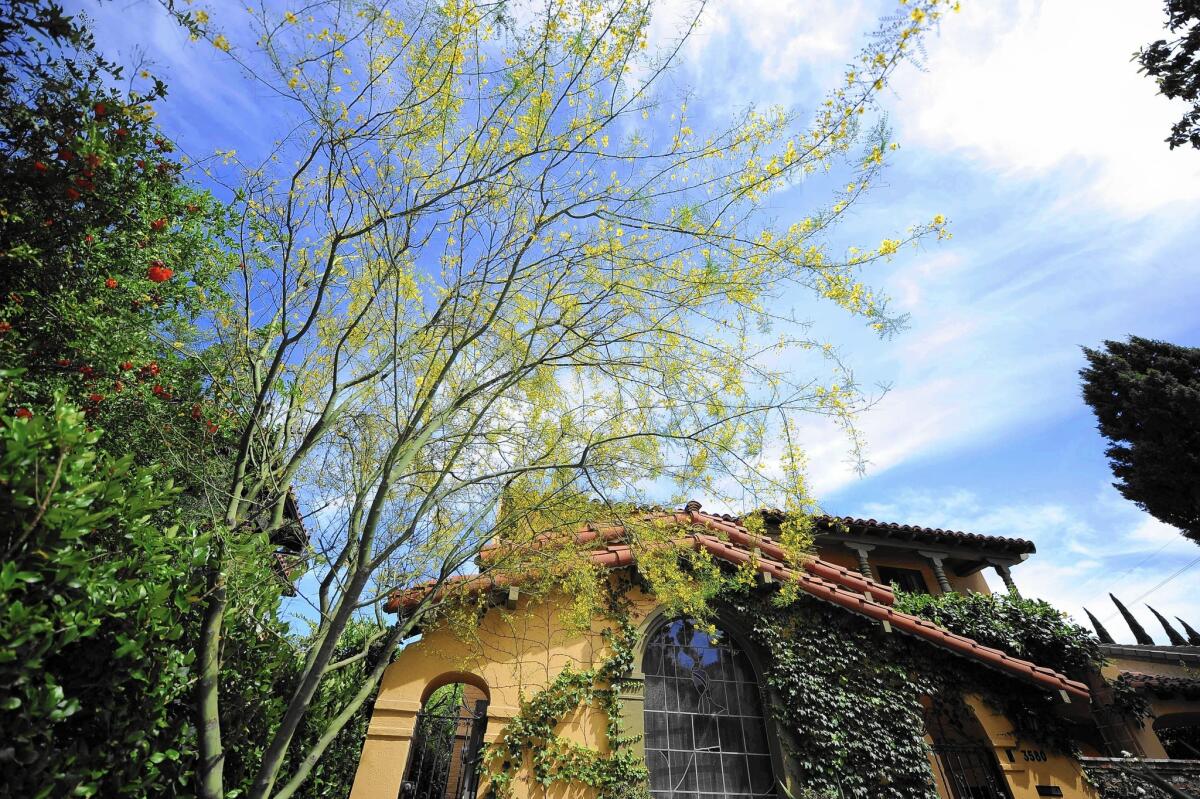See how this Los Feliz yard was transformed into a low-water oasis where it’s fun to garden again

Paula Weaver and her husband, Jay, have always gardened, even when they lived in an apartment and everything grew in pots. So part of the appeal of buying a house was the prospect of sinking their shovels into the earth.
Along with their family’s new home in Los Feliz, however, came the realization that a frontyard demanded more work than they had imagined. “It was a patch of lawn surrounded by lots of flowers,” Weaver recalls. “I’ve always liked a mixture of things, but the lawn had to be mowed, and the perennials required an incredible amount of deadheading. After several years, I got tired of that.”
But the Weavers caught a lucky break. One of their neighbors was Anthony Exter, a landscape architect with a reputation for employing geometry in unexpected and pleasing ways. While Exter was walking his dogs one day, they asked him for advice on their 44-by-25-foot yard.
“Paula was ready for a different approach, so I suggested a parterre, the kind of formal garden originally used in 15th century France,” Exter says. As counterintuitive as the idea sounded for such a tiny project, he knew that a parterre’s symmetrical framework of manicured hedges would lend welcome order plus help create the impression of a larger space.
But rather than curlicues of boxwood filled with scads of blooms (a la the gardens at Versailles), he envisioned a simpler, less labor-intensive plan: four rectangles of slow-growing dwarf olive around low-maintenance succulents. In addition to being easier to care for, the drought-tolerant plants would need less water.
The Weavers were immediately sold on Exter’s concept and had the site prepared for planting. Their magnolia-shaded lot, which sloped downward from the sidewalk to the front of the house, was regraded to flatten it and drop the ground plane slightly below the sidewalk at the same time.
“Stepping down into a sunken garden gives you a different reality, a sense of remove from the street,” Exter says. “I wanted to give them more privacy without being heavy-handed. That’s where the low Texas privet hedge came in. They’re not completely exposed anymore.”
To form the centerpiece of the garden, Exter installed “Little Ollie” dwarf olives in quadrants parallel to the street. Inside their dark green outlines he planted bright green saucer-shaped “Mint Saucer” aeoniums as well as octopus agaves, whose twisted arms sprout from concrete planters.
The aeoniums got leggy following the sun and had to be cut back regularly, so the Weavers decided to swap them out last fall. Exter substituted soap aloes, which, although tasty to foraging skunks and raccoons at first, have since become well established.
Single-file gravel paths allow the Weavers room to stroll through or tend to the yard. To one side stands a petite “Desert Museum” palo verde tree, the green trunk and branches echoing the colors of the parterre. “It’s amenable to pruning and casts some shade but doesn’t overwhelm the garden,” Exter says.
As a grace note, he designed a cylindrical poured-concrete fountain that introduces the gentle sound of recirculating water along the path to the front door. “It’s a modern interpretation of a repurposed millstone,” Exter says. “We wanted something safe, in that it wasn’t too deep, so on really hot days you can sit on the edge or just run your fingers through it.”
In the end, Exter succeeded in replacing chaos with organization, opting for plants that reduce upkeep and irrigation without sacrificing visual interest. He also created an escape from the outside world by lowering the frontyard and adding an interactive water element. Perhaps best of all: He made it possible for his clients to enjoy gardening again.
::
The four design rules you need to get the most out of a small yard
Los Angeles landscape architect Anthony Exter shares tips for getting the most out of a small yard:
• Create privacy with living walls of greenery. A background of darker foliage can make a space seem more expansive.
• Consider providing more than one path to get from Point A to Point B. A garden visible from different angles will appear bigger.
• Select plants that won’t grow too large. Choosing dwarf varieties in the beginning will mean less time and energy spent pruning later.
• Maintain a low profile. When plants and other elements are at or near the same height, sightlines remain unobstructed, producing a sense of openness.
ALSO:
Photos: 11 Inspiring water-wise landscapes
Tell us how you’re saving water during the drought, and we’ll use your best tips in print
Will L.A. become the land of front-yard veggie gardens? This couple is leading the way






